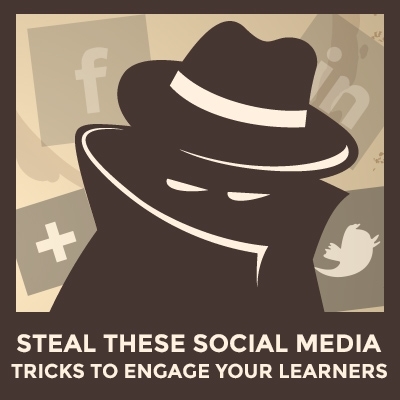Marketing experts and PR professionals know a few tricks for using social media to get their audience engaged and excited. But did you know that you could use these techniques in your e-Learning course too?
Here are 5 social media tricks - shown to improve engagement - that you can steal to boost the success of your e-Learning course
- Use images whenever you can
When you’re scrolling through your news feed on Facebook, the posts with images usually stand out, don’t they? According to Marketo, Facebook posts with images receive 53% more likes than posts with just words. Images are an easy way to engage your learners. For help on selecting the most effective images, read this post: How to Choose the Best Images for Your e-Learning. Plus, if you’re a Pinterest fan, check out this cool post on how you can use Pinterest for e-Learning: Finding e-Learning Inspiration on Pinterest. - Add a specific call to action
You’ve seen these on Facebook or Twitter, and you’ve probably even responded to some. For example, Facebook posts often tell fans to “Like” a post if they agree, “Share” it with their friends or even provide an answer in the comments. You can add a call to action in your e-Learning course with quizzes, tests and post-course surveys to get feedback. When your learners are actively participating and engaging in your course, they’re more likely to remember and get more out of the content. This post can help you design awesome assessments: The Anatomy of Great e-Learning Quiz Questions. - Length of posts (or course chunks, in your case)
Twitter has a 140 character limit; every word counts in a tweet. In addition, tweets with less than 100 characters get 17 percent more engagement, according to The Huffington Post. While you don’t want your e-Learning course to be quite that short, you can take a tip on being concise. Don’t overwhelm your learners with excess content. Instead, determine what information is the most important, and focus on that. To learn more about content priority and chunking, read this post: 4 Tips for Content Chunking in e-Learning. - Focus on the individual
When you’re communicating to a large audience, whether in a tweet or an e-Learning course, you need to find a way to make it personal to each individual. One way to do this in online training is create a scenario-based course that puts your learner in a real-life workplace situation. Want some tips? Check out this post: Building Scenario-Based e-Learning Courses. You should also keep different learning styles in mind; visual, auditory, kinesthetic and tactile learners all engage a little differently. To learn how to design for all your learners, read this post: How to Accommodate the 4 Learning Styles in Your Online Training. - Go mobile
60% of the time people spend on social media is spent on smartphones and tablets—as opposed to desktop computers. That’s why you can get a Twitter or Facebook app for your phone, so you can stay connected on the go. Your learners can stay connected wherever they are too if you employ mobile learning at your organization! That way, they can view your e-Learning content anywhere, anytime with m-Learning solutions like Lectora Mobile.
Want to find more e-Learning tips in unexpected places? Check out this blog post: 5 Lessons from Writing 101 You Thought You’d Never Need for e-Learning. Plus, here’s a great blog post with more ways to engage your learners: How to Make Online Compliance Training More FUN.One authoring tool that makes it easy to incorporate social media elements in your e-Learning courses is Lectora Inspire. Start your free 30-day trial today!

